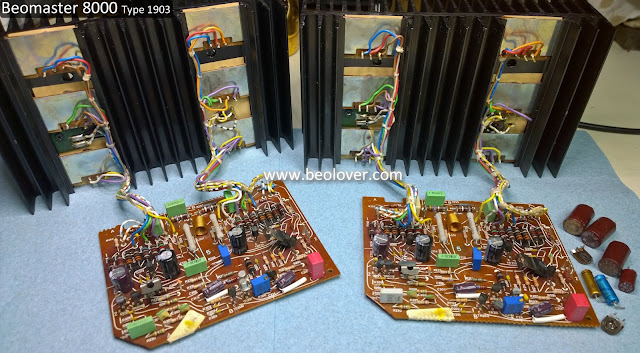Here are the two sets of output amplifier boards I had to test and make initial adjustments on (the two boards from the Canada Beomaster 8000 and the two boards from the Texas Beomaster 8000).
As a reference I have one of my spare output amplifier assemblies. I start with the spare board in getting my bench test setup.
I use two 60V bench power supplies to supply the ±55V rail voltages for the output amplifier board.
As a protection measure each supply is set to limit its current output to 150mA. A properly adjusted Beomaster 8000 output amplifier will draw around 100mA to 120mA when the board is powered up and the no-load current is set. If a fault exists that attempts to draw too much current, these supplies will shut down before any collateral damage can occur.
I use a 30V bench power supply to provide the +15V to the board that controls the output amplifier being on or off.
The ±55V voltages are applied first. This is done slowly to monitor the current draw.
With the board off, the +15V supply at zero volts, the ±55V supplies should draw between 20mA and 30mA.
When the +15V supply is applied the output amplifier will be on and the current draw is around 100mA.
The no-load current adjustment is performed with no speaker load and zero volts on the audio inputs. When the output amplifier is fully powered on and is not amplifying any audio signal the voltage across the output emitter resistors should be at 18mV.
For the DC offset adjustment the speaker load is applied and the audio input signal remains at zero volts. The voltage across the speaker load is measured and adjusted to 0V ±5mV.
After confirming the test setup and procedure with the spare board I started with adjusting the left channel output amplifier board for the Beomaster from Canada.
As I started to apply the +15V control voltage I monitored the ±55V supplies. With only about 3V applied from the +15V supply my ±55V supplies were already at 120mA
That can happen on a newly restored board and means the no-load current adjustment trimmer needs to be dialed down.
I use the expected 100mA ±55V supply current draw as my guide to adjust the no-load current trimmer as I adjust the +15V supply up to its full voltage.
When that is reached I should have about 18mV across the emitter resistors.
I followed that up with the DC offset adjustment. To do than I turned the +15V supply back down to zero to turn off the output amplifier. Then I attached the speaker load and powered up the +15V supply again and performed the adjustment.
I removed power for the left channel output amplifier board and swapped in the right channel board.
I tested the right channel board the same way and finished it up with the DC offset adjustment.
That successfully completes the two output amplifier assemblies for the Beomaster 8000 from Canada.
Next up are the two output amplifiers from the Texas Beomaster 8000 unit.
I started with the board from the left channel again.
It adjusted easily for the no-load current and the DC offset. The adjustment procedure seems to get easier when I can do several in one bench test sitting.
The right channel board also adjusted easily.



















































